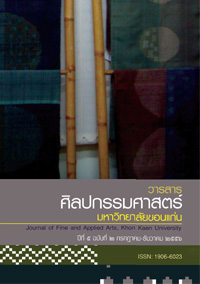การผสมผสานวัฒนธรรมอีสานร่วมสมัยในงานออกแบบอัตลักษณ์ตราสินค้า
Main Article Content
Abstract
สินค้าวัฒนธรรมพื้นถิ่นอีสานร่วมสมัย เป็นตัวอย่างในการสร้างเป็นมูลค่า เพิ่มให้กับสินค้าผ่านลักษณะเด่นของวัฒนธรรมพื้นถิ่น ซึ่งโดยทั่วไปแนวทางการ สร้างอัตลักษณ์สินค้าวัฒนธรรมอีสานร่วมสมัยนี้ได้ถูกเชื่อว่าเป็นการสร้างโอกาสเติบโตทางเศรษฐกิจสู่ท้องถิ่นผ่านรูปแบบของสินค้าที่มีร่วมสมัยมากยิ่งขึ้น แต่งาน วิจัยชิ้นนี้ได้ตั้งข้อโต้แย้งที่ว่า ในอีกมุมมองหนึ่งนั้นความหมายของความเป็นอีสานน ยังคงถูกกำหนดและควบคุมให้มีลักษณะเฉพาะ ซึ่งนำไปสู่การกำหนดทัศนคติของ ผู้บริโภคต่อความหมายของวัฒนธรรมพื้นถิ่นอีสานให้มีลักษณะที่หยุดนิ่งและตายตัว ยากที่จะปรับเปลี่ยนไปสู่ความร่วมสมัย ดังที่ผู้วิจัยเห็นว่าวัฒนธรรมวิถีชีวิตความ เป็นอีสานนั้นควรจะสามารถเปลี่ยนแปลงและพัฒนาไปได้ตามบริบทหรือกาลเวลา
จากสมมติฐานดังกล่าว นำมาสู่การวิจัยเรื่องการผสานวัฒนธรรมพื้นถิ่น ในงานออกแบบอัตลักษณ์ตราสินค้าอีสานร่วมสมัย ซึ่งจากผลการศึกษาที่สามารถ ตรวจสอบสมมติฐานที่ตั้งไว้แล้ว ยังนำมาสู่การสร้างแนวทางการออกแบบอัตลักษณ์ ตราสินค้าอีสานร่วมสมัยในเชิงทดลอง ที่จะเป็นการเพิ่มโอกาสให้ความเป็นอีสานมี การเปลี่ยนแปลงไปยังความหมายในบริบทอื่นๆ ที่มีความหลากหลาย โดยผู้วิจัยได้ ทำการออกแบบผ่านแนวคิดการสร้างอัตลักษณ์สินค้าให้มีความยืดหยุ่น (Flexibility) และการเปิดโอกาสให้ผู้บริโภคเข้ามามีส่วนร่วม ซึ่งแม้ว่ากระบวนการทดลองนี้จะเป็น เพียงจุดเริ่มต้น แต่แนวทางนี้มีแนวโน้มที่จะสามารถช่วยให้เราเปลี่ยนแปลงทัศนคติ เกี่ยวกับอัตลักษณ์ของวัฒนธรรม จากที่เคยถูกกำหนดให้มีความเฉพาะ หยุดนิ่ง มา สู่แนวคิดว่าสามารถเปลี่ยนแปลงพัฒนาได้ ดังที่งานวิจัยนี้ได้โต้แย้งไว้ในขั้นต้น ผ่าน แนวคิดเกี่ยวกับความเป็นพหุลักษณ์ การผสมผสานและการเปลี่ยนแปลงสู่ความ หลากหลายทางบริบท ดังนั้นจึงจะไม่ใช่เรื่องแปลกเลยที่สินค้าวัฒนธรรมอีสานจะ ปรากฏขึ้นในรูปแบบของบริบทสังคมวัฒนธรรมยุคหลังสมัยใหม่ต่อไป
Contemporary Isan Cultural Hybridization in Brand Identity Design
“Contemporary Isan cultural Brand Identity” is an example focusing on how to use the characteristics of Isan Culture to create a new value into products. Many people believe that such approach is able to increase business opportunities by inserting new contemporary meanings and representations, but as this paper strongly argues, the notion of Isan Culture paradoxically becomes fi xed and controlled. Consumer’s perception of Isan cultural identity is unfortunately infl exible, that make it diffi cult to adapt to modern culture. As far as my argument concerns Isan culture should be developed and changed over contexts or times.
This assumption leads to the research of Local Cultural Hybridization in Contemporary Isan Brand Identity Design. The results of this study can determine assumptions and also lead to create the experimental Contemporary Isan Culture Brand Identity design that could provide signifi cation opportunities of Isan Culture to be fl exible and variable. This experiment has designed based on the concept of fl exible brand identity and new ways of consumers’ participation. Although the experiment is in the beginning process, it seems to enable us to move away from the fi xed notion of cultural identity. Surely, it needs to be developed – as what this paper argues for – through the notion of multiple appearances, hybridization, and diversity. So, it is not surprising that Isan Culture Brand Identity could be seen in the light of Postmodern Era.
Article Details
Content and information in articles published in the Journal of Fine and Applied Arts of Khon Kaen University is regarded as the opinion and sole responsibility of the author(s) directly; therefore, editors are not obliged to agree to or share any responsibility with regard to the content and information that appears within these articles.
All articles, information, content, image, etc. that have been published in the Journal of Fine and Applied Arts of Khon Kaen University is the copyright of the Journal of Fine and Appllied Arts of Khon Kaen University. Any person or organization who wishes to distribute all or parts of the articles for further dissemination or other usage must first receive permission from the Journal of Fine and Applied Arts of Khon Kaen University before proceeding to do so.


